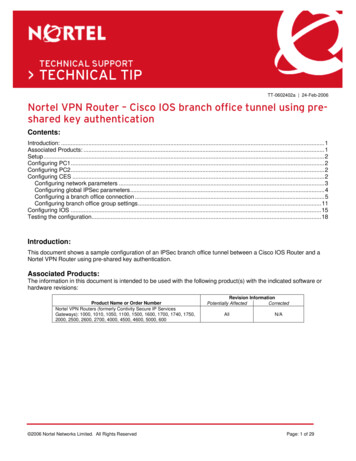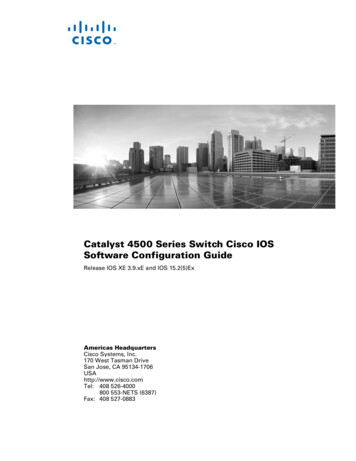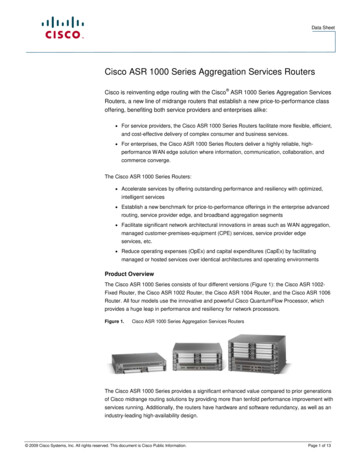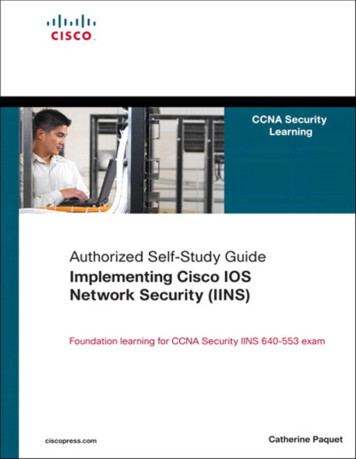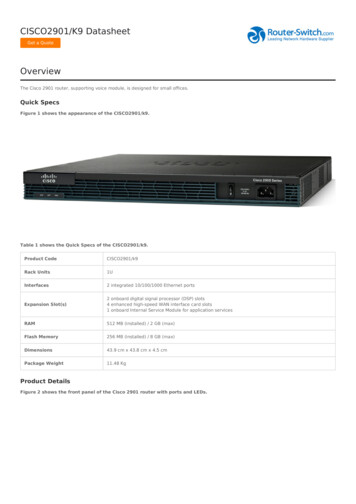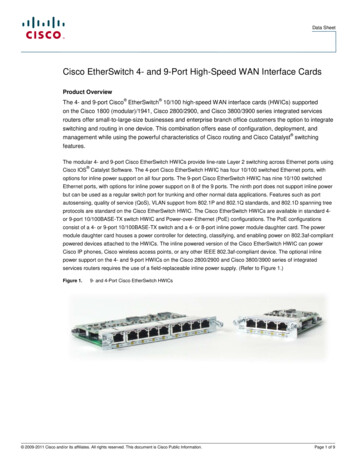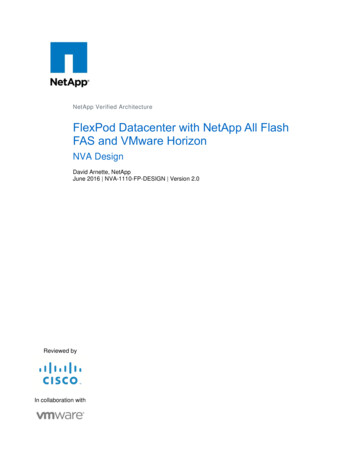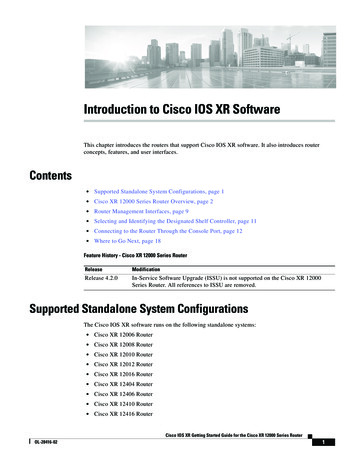
Transcription
Introduction to Cisco IOS XR SoftwareThis chapter introduces the routers that support Cisco IOS XR software. It also introduces routerconcepts, features, and user interfaces.Contents Supported Standalone System Configurations, page 1 Cisco XR 12000 Series Router Overview, page 2 Router Management Interfaces, page 9 Selecting and Identifying the Designated Shelf Controller, page 11 Connecting to the Router Through the Console Port, page 12 Where to Go Next, page 18Feature History - Cisco XR 12000 Series RouterReleaseModificationRelease 4.2.0In-Service Software Upgrade (ISSU) is not supported on the Cisco XR 12000Series Router. All references to ISSU are removed.Supported Standalone System ConfigurationsThe Cisco IOS XR software runs on the following standalone systems: Cisco XR 12006 Router Cisco XR 12008 Router Cisco XR 12010 Router Cisco XR 12012 Router Cisco XR 12016 Router Cisco XR 12404 Router Cisco XR 12406 Router Cisco XR 12410 Router Cisco XR 12416 RouterCisco IOS XR Getting Started Guide for the Cisco XR 12000 Series RouterOL-28416-021
Introduction to Cisco IOS XR SoftwareCisco XR 12000 Series Router OverviewNoteMany cards operate in both Cisco XR 12000 Series Routers and in Cisco 12000 Series Internal Routers.For the latest information on which cards are supported by the Cisco IOS XR software inCisco XR 12000 Series Routers and Cisco 12000 Series Internal Routers, see Release Notes forCommand Cisco IOS XR Software Release 4.0.Cisco XR 12000 Series Router OverviewThe Cisco XR 12000 Series Router is powered by Cisco IOS XR software, allowing service providers toisolate public and private services through the virtualization of a single router into separate physical andlogical partitions. Cisco IOS XR software is a unique self-healing and self-defending operating systemdesigned for always-on operation while scaling capacity and adding new services or features. Withdistributed processing intelligence and robust quality-of-service (QoS) and multicast mechanisms, theCisco XR 12000 Series Router allows providers to scale services and customers with performance.Features and CapabilitiesThe router is a scalable carrier-class distributed forwarding router, which is designed for redundancy,high security and availability, packaging, power, and other requirements needed by service providers.The router aggregates triple play Multi-service edge and Ethernet service traffic aggregating theseservices to 10 Gigabit Ethernet IP, MPLS edge, or core. It support Ethernet, serial (including MLPPP),frame relay and POS interface on the access side and Ethernet or POS interfaces on the core side.The following sections describe the features and capabilities in detail: Cisco IOS XR Software, page 2 Flexible Ethernet, page 5 L2VPN, page 5 Multicast, page 6 OAM, page 6 Layer 3 Routing, page 7 MPLS VPN, page 8 QoS, page 8 MPLS TE, page 9Cisco IOS XR SoftwareThe router runs Cisco IOS XR Software, which offers the following: Rich Networking Feature Set—Cisco IOS XR Software represents a continuation of the Cisconetworking leadership in helping customers realize the power of their networks and the Internet. Itprovides unprecedented routing-system scalability, high availability, service isolation, andmanageability to meet the mission-critical requirements of next-generation networks.Cisco IOS XR Getting Started Guide for the Cisco XR 12000 Series Router2OL-28416-02
Introduction to Cisco IOS XR SoftwareCisco XR 12000 Series Router Overview Operating system infrastructure protection—Cisco IOS XR Software provides a microkernelarchitecture that forces all but the most critical functions, such as memory management and threaddistribution, outside of the kernel, thereby preventing failures in applications, file systems, and evendevice drivers from causing widespread service disruption. Process and thread protection—Each process, even individual process thread, is executed in its ownprotected memory space, and communications between processes are accomplished throughwell-defined, secure, and version-controlled application programming interfaces (APIs),significantly minimizing the effect that any process failure can have on other processes. Process restart—You can restart critical control-plane processes both manually and automatically inresponse to a process failure versus restarting the entire operating system. This feature supports theCisco IOS XR Software goal of continuous system availability and allows for quick recovery fromprocess or protocol failures with minimal disruption to customers or traffic. State checkpoint—You can maintain a memory and critical operating state across process restarts tosustain routing adjacencies and signaling state during a Route Switch Processor (RSP) switchover. Ethernet virtual connections (EVCs)—Ethernet services are supported using individual EVCs tocarry traffic belonging to a specific service type or end user through the network. You can useEVC-based services in conjunction with MPLS-based L2VPNs and native IEEE bridgingdeployments. Flexible VLAN classification—VLAN classification into Ethernet flow points (EFPs) includessingle-tagged VLANs, double-tagged VLANs (QinQ and IEEE 802.1ad), contiguous VLAN ranges,and noncontiguous VLAN lists. IEEE Bridging—Software supports native bridging based on IEEE 802.1Q, IEEE 802.1ad, IEEE802.1ah provider backbone bridges (PBB) and QinQ VLAN encapsulation mechanisms on therouter. IEEE 802.1s Multiple Spanning Tree (MST)—MST extends the IEEE 802.1w Rapid Spanning TreeProtocol (MSTP) to multiple spanning trees, providing rapid convergence and load balancing. MST Access Gateway—This feature provides a resilient, fast-convergence mechanism foraggregating and connecting to Ethernet-based access rings. Virtual Private LAN Services (VPLS)—VPLS is a class of VPN that supports the connection ofmultiple sites in a single, bridged domain over a managed IP/MPLS network. It presents an Ethernetinterface to customers, simplifying the LAN and WAN boundary for service providers andcustomers, and enabling rapid and flexible service provisioning because the service bandwidth isnot tied to the physical interface. All services in a VPLS appear to be on the same LAN, regardlessof location. Hierarchical VPLS (H-VPLS)—H-VPLS provides a level of hierarchy at the edge of the VPLSnetwork for increased scale. QinQ access and H-VPLS pseudowire access options are supported. Virtual Private WAN Services/Ethernet over MPLS (VPWS/EoMPLS)—EoMPLS transportsEthernet frames across an MPLS core using pseudowires. Individual EFPs or an entire port can betransported over the MPLS backbone using pseudowires to an egress interface or subinterface. Pseudowire redundancy—Pseudowire redundancy supports the definition of a backup pseudowire toprotect a primary pseudowire that fails. Multisegment pseudowire stitching—Multisegment pseudowire stitching is a method forinterworking two pseudowires together to form a cross-connect relationship. IPv4 Multicast—IPv4 Multicast supports Internet Group Management Protocol Versions 2 and 3(IGMPv2/v3), Protocol Independent Multicast Source Specific Multicast (SSM) and Sparse Mode(SM), Multicast Source Discovery Protocol (MSDP), and Anycast Rendezvous Point (RP).Cisco IOS XR Getting Started Guide for the Cisco XR 12000 Series RouterOL-28416-023
Introduction to Cisco IOS XR SoftwareCisco XR 12000 Series Router Overview IGMP v2/v3 Snooping—This Layer 2 mechanism efficiently tracks multicast membership on anL2VPN network. Individual IGMP joins are snooped at the VLAN level or pseudowire level, andthen it summarizes the results into a single upstream join message. In residential broadbanddeployments, this feature enables the network to send only channels that are being watched to thedownstream users. N-Tuple Hashing—A new 7-tuple hash algorithm, which provides better load balancing across equalcost paths, is introduced. This algorithm uses additional Layer 4 information from the Layer 3packet. For more information on 7-tuple hashing, see the Cisco IOS XR IP Addresses and ServicesConfiguration Guide for the Cisco XR 12000 Series Router. Link Bundling Phase 3—The link bundle interface is enabled to be used as an edge-facing interfaceby providing a number of new features, such as ACL, Mac Accounting, IPv6, PIMv6, uRPF, MVPN,L2VPN, BFD, and Unequal BW. For more information on link bundling phase 3, see the Cisco IOSXR Interface and Hardware Component Configuration Guide for the Cisco XR 12000 Series Router. High Availability for Lawful Intercept—This feature provides operational continuity of the TAPflows and provisioned MD tables to reduce loss of information due to route processor fail over(RPFO). For more information on high availability for lawful intercept, see the Cisco IOS XR SystemSecurity Configuration Guide for the Cisco XR 12000 Series Router. Circuit Emulation over Packet Switched Network (CEoP)—This is a way to carry TDM circuits overpacket switched network. For more information see the Cisco IOS XR Interface and HardwareComponent Configuration Guide for the Cisco XR 12000 Series Router. Multiple Group Optimization (MGO) for HSRP—This feature provides a solution for reducingcontrol traffic in a deployment consisting of many subinterfaces. For more information on how toreduce the traffic using the MGO, see the Cisco IOS XR IP Addresses and Services ConfigurationGuide for the Cisco XR 12000 Series Router. Generalized Multiprotocol Label Switching (GMPLS) User Network Interface (UNI)—This featurecreates a circuit connection between two clients (UNI-C) of an optical network. For moreinformation on GMPLS UNI, see the Cisco IOS XR MPLS Configuration Guide for the Cisco XR12000 Router. Flow-Aware Transport Pseudowire (FAT PW) loadbalancing—This feature provides routers theability to loadbalance traffic in the core when equal cost multipaths (ECMP) are used by creating aflow label based on indivisible packet flows entering a pseudowire and inserting as the lower mostlabel in the packet. For more information, see the Cisco IOS XR Virtual Private NetworkConfiguration Guide for the Cisco XR 12000 Series. Wide Metric Support for Enhanced Interior Gateway Routing Protocol (EIGRP)—This featureprovidse metric values while redistributing a protocol into an EIGRP interface for a wide variety ofnetworks. For more information on wide metric support for EIGRP, see the Cisco IOS XR RoutingConfiguration Guide for the Cisco XR 12000 Series Router. BGP-RIB Feedback Mechanism—This feature configures BGP to wait for feedback from RIBindicating that the routes that BGP installed in RIB have been installed in FIB, before BGP send outupdates to neighbors. For information on how to implement BGP-RIB Feedback Mechanism, seetheCisco IOS XR Routing Configuration Guide for the Cisco XR 12000 Series Router. IPv6 Service Level Agreements (SLA) Internet Control Message Protocol (ICMP) Echo Op EOT forHSRIPv6and IP Static— This feature is used to monitor end-to-end response time between a Ciscorouter and devices using IP. For more information on IPv6 SLA ICMP Echo Op EOT, see the CiscoIOS XR IP Addresses and Services Configuration Guide for the Cisco XR 12000 Series Router.Cisco IOS XR Getting Started Guide for the Cisco XR 12000 Series Router4OL-28416-02
Introduction to Cisco IOS XR SoftwareCisco XR 12000 Series Router Overview Asynchronous Syslog Communication—This feature enables proper ordering of messages testingon each node (LC, RP), non dropping of messages generated from multiple clients on each node(LC, RP) and checking performance, scalability and latency by sending log messages at incrementalrates. For more information on Asynchronus Syslog Communication, see theCisco IOS XR SystemManagement Configuration Guide for the Cisco XR 12000 Series Router. Syslog Enhancement—This feature enables adding keywords year in both service timestamp logdatetime and service timestamp debug datetime and severity in the existing logging cli. For moreinformation on Syslog Enhancement, see the Cisco IOS XR System Monitoring Command Referencefor the Cisco XR 12000 Series Router. Next-Generation MVPN—This feature offers more scalability for Layer 3 VPN multicast traffic andallows point-to-multipoint Label Switched Paths (LSP) to be used to transport the multicast trafficbetween PEs. For more information on Next-Generation MVPN, see the Cisco IOS XR VirtualPrivate Network Configuration Guide for the Cisco XR 12000 Series Router. Multiple Group Optimization (MGO) for Virtual Router Redundancy Protocol (VRRP)— Thisfeature provides a solution for reducing control traffic in a deployment consisting of manysubinterfaces. For more information on MGO for VRRP, see the Cisco IOS XR IP Addresses andServices Configuration Guide for the Cisco XR 12000 Series Router. HSRPv6—This feature provides support for HSRP version 2, which provides an extended grouprange of 0-4095. For more information on HSRPv6, see the Cisco IOS XR IP Addresses and ServicesConfiguration Guide for the Cisco XR 12000 Series Router.Flexible EthernetThe router uses Ethernet as its transport mechanism, which offers the following: Flexible VLAN classification—VLAN classification into EFPs includes single-tagged VLANs,double-tagged VLANs (QinQ and IEEE 802.1ad), contiguous VLAN ranges, and noncontiguousVLAN lists. IEEE Bridging— The software supports native bridging based on IEEE 802.1Q, IEEE 802.1ad, andQinQ VLAN encapsulation mechanisms on the router. IEEE 802.1s Multiple Spanning Tree (MST)—MST extends the MSTP to multiple spanning trees,providing rapid convergence and load balancing. MST Access Gateway—This feature provides a resilient, fast-convergence mechanism foraggregating and connecting to Ethernet-based access rings.L2VPNThe router uses L2VPNs, which offers the following: Virtual Private LAN Services (VPLS)—VPLS is a class of VPN that supports the connection ofmultiple sites in a single, bridged domain over a managed IP/MPLS network. It presents an Ethernetinterface to customers, simplifying the LAN and WAN boundary for service providers andcustomers, and enabling rapid and flexible service provisioning because the service bandwidth isnot tied to the physical interface. All services in a VPLS appear to be on the same LAN, regardlessof location. Hierarchical VPLS (H-VPLS)—H-VPLS provides a level of hierarchy at the edge of the VPLSnetwork for increased scale. QinQ access and H-VPLS pseudowire access options are supported.Cisco IOS XR Getting Started Guide for the Cisco XR 12000 Series RouterOL-28416-025
Introduction to Cisco IOS XR SoftwareCisco XR 12000 Series Router Overview Virtual Private WAN Services/Ethernet over MPLS (VPWS/EoMPLS)—EoMPLS transportsEthernet frames across an MPLS core using pseudowires. Individual EFPs or an entire port can betransported over the MPLS backbone using pseudowires to an egress interface or subinterface. Pseudowire redundancy—Pseudowire redundancy supports the definition of a backup pseudowire toprotect a primary pseudowire that fails. Multisegment pseudowire stitching—This feature is a method used to interwork two pseudowirestogether to form a cross-connect relationship. Local Switched Routed for (FR, ATM, PPP, HDLC,Ethernet) / Bridged Interworking for (FR,ATM))—This feature enables service providers to connect customer sites with existing Layer 2networks by using a single, integrated, packet-based network infrastructure. For more informationon using this feature, see the Cisco IOS XR Virtual Private Network Configuration Guide for theCisco XR 12000 Series Router. L2VPN Nonstop Routing (NSR) and L2VPN Scale Enhancements— This feature enables to avoidlabel distribution path (LDP) sessions from flapping on events such as process failures (cras h) androute processor failover (RP FO). For more information on L2VPN NSR, see the Cisco IOS XRVirtual Private Network Configuration Guide for the Cisco XR 12000 Series Router. Pseudowire (PW) Grouping— This feature enables assigning each PW a group ID that is commonfor all PWs created from the same physical port. Hence, when the physical port becomesnon-functional or is deleted, L2VPN sends a single message to advertise the status change of allPWs belonging to the group. For more information on configuring pseudowire groups, see the CiscoIOS XR Virtual Private Network Configuration Guide for the Cisco XR 12000 Series RouterMulticastThe router supports multicast, which offers the following: IPv4 Multicast—IPv4 Multicast supports Internet Group Management Protocol Versions 2 and 3(IGMPv2/v3), Protocol Independent Multicast Source Specific Multicast (SSM) and Sparse Mode(SM), Multicast Source Discovery Protocol (MSDP), and Anycast Rendezvous Point (RP). IGMP v2/v3 Snooping—This Layer 2 mechanism efficiently tracks multicast membership on anL2VPN network. Individual IGMP joins are snooped at the VLAN level or pseudowire level, andthen it summarizes the results into a single upstream join message. In residential broadbanddeployments, this feature enables the network to send only channels that are being watched to thedownstream users.OAMThe router supports different types of operations, administration, and maintenance (OAM), which offersthe following: E-OAM (IEEE 802.3ah)—Ethernet link layer OAM is a vital component of EOAM that providesphysical-link OAM to monitor link health and assist in fault isolation. Along with IEEE 802.1ag,Ethernet link layer OAM can be used to assist in rapid link-failure detection and signaling to remoteend nodes of a local failure. E-OAM (IEEE 802.1ag and ITU-T Y.1731)—Ethernet Connectivity Fault Management (CFM) is aservice-level OAM protocol that provides a number of mechanisms for fault management andperformance monitoring. This includes procedures for monitoring and verifying the path betweenmultiple end points, via IEEE 802.1 bridges and LANs. MPLS OAM—This protocol supports Label Switched Path (LSP) ping, LSP TraceRoute, and VirtualCircuit Connectivity Verification (VCCV). .Cisco IOS XR Getting Started Guide for the Cisco XR 12000 Series Router6OL-28416-02
Introduction to Cisco IOS XR SoftwareCisco XR 12000 Series Router Overview Ethernet SLA (Service Level Agreement)—The router supports a feature-rich manageabilityinterface for performance monitoring, using the capabilities provided by the Ethernet CFM. Ethernet Fault Detection—The router supports a mechanism to use faults detected by Ethernet OAMprotocols as a trigger to bring down interfaces or sub-interfaces. Hence, there is a trigger protectionswitching or L3 re-routing during a failure.Layer 3 RoutingThe router runs Cisco IOS XR Software, which supports Layer 3 routing and a range of IPv4 servicesand routing protocols, including the following: Intermediate System-to-Intermediate System (IS-IS)—Integrated Intermediate IS-IS, InternetProtocol Version 4 (IPv4), is a standards-based Interior Gateway Protocol (IGP). For moreinformation on IS-IS, see Cisco IOS XR Routing Configuration Guide for the Cisco XR 12000 SeriesRouter. Open Shortest Path First (OSPF)—OSPF is an IGP developed by the OSPF working group of theInternet Engineering Task Force (IETF). For more information on OSPF, see Cisco IOS XR RoutingConfiguration Guide for the Cisco XR 12000 Series Router. Static Routing—Static routes are user-defined routes that cause packets moving between a sourceand a destination to take a specified path. For more information on static routing, see Cisco IOS XRRouting Configuration Guide for the Cisco XR 12000 Series Router. IPv4 Multicast—IPv4 Multicast delivers source traffic to multiple receivers without adding anyadditional burden on the source or the receivers while using the least network bandwidth of anycompeting technology. For more information on IPv4 Multicast, see Cisco IOS XR MulticastConfiguration Guide for the Cisco XR 12000 Series Router. Routing Policy Language (RPL)—RPL provides a single, straightforward language in which allrouting policy needs can be expressed. For more information on RPL, see Cisco IOS XR RoutingConfiguration Guide for the Cisco XR 12000 Series Router. Hot Standby Router Protocol (HSRP)—HSRP is an IP routing redundancy protocol designed toallow for transparent failover at the first-hop IP router. For more information on HSRP, see CiscoIOS XR IP Addresses and Services Configuration Guide for the Cisco XR 12000 Series Router. Virtual Router Redundancy Protocol (VRRP)—VRRP allows for transparent failover at the first-hopIP router, enabling a group of routers to form a single virtual router. For more information on VRRP,see Cisco IOS XR IP Addresses and Services Configuration Guide for the Cisco XR 12000 SeriesRouter. Border Gateway Protocol (BGP) Add Path— This feature enables a BGP speaker to send multiplepaths for a prefix. For more information on BGP Add Path, see Cisco IOS XR Routing ConfigurationGuide for the Cisco XR 12000 Series Router. Selective VRF Download (SVD)—This feature allows to download only those prefixes and labelsto a line card that are actively required to forward traffic through that line card. For more informationon SVD, see the Cisco IOS XR Routing Configuration Guide for the Cisco XR 12000 Series Router. Route Convergence Monitoring and Diagnostics (RCMD)—This feature enables convergencemonitoring for SPF events and specific individual prefixes in OSPF and IS-IS. For more informationon RCMD, see the Cisco IOS XR Routing Configuration Guide for the Cisco XR 12000 SeriesRouter.Cisco IOS XR Getting Started Guide for the Cisco XR 12000 Series RouterOL-28416-027
Introduction to Cisco IOS XR SoftwareCisco XR 12000 Series Router Overview Route and Label Consistency Checker (RCC and LCC)—The RCC and LCC is used to verify theconsistency between control plane and data plane route and label programming in IOS XR Software.For more information on how to use the RCC and LCC, see the Cisco IOS XR Routing ConfigurationGuide for the Cisco XR 12000 Series Router. System-Wide Route and Label Prioritization—This feature provides faster and more consistentInterior Gateway Protocol (IGP) convergence due to router or network events. For more informationon how to prioritize and download the critical routes and labels, see the Cisco IOS XR RoutingConfiguration Guide for the Cisco XR 12000 Series Router.MPLS VPNThe router supports MPLS VPN, which offers the following: MPLS L3VPN—This IP VPN feature for MPLS allows a Cisco IOS Software orCisco IOS XR software network to deploy scalable IPv4 Layer 3 VPN backbone services. An IPVPN is the foundation that companies use for deploying or administering value-added services,including applications and data hosting network commerce and telephony services, to businesscustomers. Carrier Supporting Carrier (CSC)—CSC allows an MPLS VPN service provider to connectgeographically isolated sites using another backbone service provider and still maintain a privateaddress space for its customer VPNs. It is implemented as defined by IETF RFC 4364. Inter-AS—is a peer-to-peer type model that allows extension of VPNs through multiple provider ormulti-domain networks. This lets service providers peer up with one another to offer end-to-endVPN connectivity over extended geographical locations. An MPLS VPN Inter-AS allows:– VPN to cross more than one service provider backbone.– VPN to exist in different areas.– Confederations to optimize Internal Border Gateway Protocol (iBGP) meshing.QoSThe router supports many types of quality of service (QoS), which offers the following: QoS—Comprehensive QoS support with up to 3 million queues, Class-Based Weighted FairQueuing (CBWFQ) based on a three-parameter scheduler, Weighted Random Early Detection(WRED), two-level strict priority scheduling with priority propagation, and 2-rate, 3-color (2R3C)Policing are all supported. Cisco IOS XR Software—This software supports a rich variety of QoS mechanisms, includingpolicing, marking, queuing, dropping, and shaping. In addition, the operating systems supportModular QoS CLI (MQC). Modular CLI is used to configure various QoS features on various Ciscoplatforms. H-QoS—Is supported on Ethernet interfaces. For EVCs four-level H-QoS support is provided withthe following hierarchy levels: port, group of EFPs, EFP, and class of service. This level of supportallows for per-service and per-end user QoS granularity. Four-level H-QoS support is provided forEVCs with the following hierarchy levels: port, group of EFPs, EFP, and class of service. This levelof support allows for per-service and per-end user QoS granularity. H-QOS support is also providedon SIP based interfaces.Cisco IOS XR Getting Started Guide for the Cisco XR 12000 Series Router8OL-28416-02
Introduction to Cisco IOS XR SoftwareRouter Management Interfaces Shared Policy Instance (SPI)—This feature provides the ability to share the service-policy instanceamong multiple ethernet flow points (EFPs) or L3/L2 subinterfaces on the same interface. For moreinformation on SPI, see the Cisco IOS XR Modular Quality of Service Configuration Guide for theCisco XR 12000 Series Router.MPLS TEThe router supports MPLE Traffic Engineering (TE), which offers the following: MPLS TE—Cisco IOS XR Software supports MPLS protocols such as Traffic Engineering/FastReroute (TE-FRR), Resource Reservation Protocol (RSVP), Label Distribution Protocol (LDP), andTargeted Label Distribution Protocol (T-LDP). MPLS TE Preferred Path—Preferred tunnel path functions let you map pseudowires to specific TEtunnels. Attachment circuits are cross-connected to specific MPLS TE tunnel interfaces instead ofremote provider-edge router IP addresses (reachable using IGP or LDP). Ignore Intermediate System-to-Intermediate System (IS-IS) Overload Bit Avoidance—This featureallows network administrators to prevent a RSVP-TE Label Switched Path (LSP) from beingdisabled when a router in that path has its Intermediate System-to-Intermediate System (IS-IS)overload bit set. For more information on IS-IS overload bit aviodance, see the Cisco IOS XR MPLSConfiguration Guide for the Cisco XR 12000 Series Router. Soft-Preemption—Soft-Preemption is an extension to the RSVP-TE protocol to minimize oreliminate the traffic disruption over the preempted Label Switched Paths(LSP). For moreinformation on how to achieve zero traffic loss, see the Cisco IOS XR MPLS Configuration Guidefor the Cisco XR 12000 Series Router. Path-Option Attributes—The Path-Option Attributes are configurable through a templateconfiguration. This template, named attribute-set, is configured globally in the MPLStraffic-engineering mode. For more information on how to implement path option attributes, see theCisco IOS XR MPLS Configuration Guide for the Cisco XR 12000 Series Router.For the complete list of New and Changed features, see the Cisco IOS XR Release Notes at:http://www.cisco.com/en/US/products/ps5845/prod release notes list.html.Router Management InterfacesBecause new routers are not yet configured for your environment, you must begin the configurationusing the command-line interface (CLI). This guide provides instructions on using the CLI to configurebasic router features. Cisco IOS XR software supports the following router management interfaces,which are described in the following sections: Command-Line Interface, page 9 Extensible Markup Language API, page 10 Simple Network Management Protocol, page 10Command-Line InterfaceThe CLI is the primary user interface for configuring, monitoring, and maintaining routers that runCisco IOS XR software. The CLI allows you to directly and simply execute Cisco IOS XR commands.Cisco IOS XR Getting Started Guide for the Cisco XR 12000 Series RouterOL-28416-029
Introduction to Cisco IOS XR SoftwareRouter Management InterfacesAll procedures in this guide use CLI. Before you can use other router management interfaces, you mustfirst use the CLI to install and configure those interfaces. Guidelines for using the CLI to configure therouter are discussed in the following chapters: Configuring General Router Features Configuring Additional Router Features CLI Tips, Techniques, and ShortcutsFor more information on CLI procedures for other tasks, such as hardware interface and softwareprotocol management tasks, see the Cisco IOS XR software documents listed in the “RelatedDocuments” section on page x.Extensible Markup Language APIThe Extensible Markup Language (XML) application programming interface (API) is an XML interfaceused for rapid development of client applications and perl scripts to manage and monitor the router.Client applications can be used to configure the router or request status information from the router byencoding a request in XML API tags and sending it to the router. The router processes the request andsends the response to the client in the form of encoded XML API tags. The XML API supports readilyavailable transport layers, including Telnet, SSH, and Common Object Request Broker Architecture(CORBA). The Secure Socket Layer (SSL) transport is also supported by the XML API.For more information, see the Cisco IOS XR software documents listed in the “Related Documents”section on page x.Simple Network Management ProtocolSimple Network Management Protocol (SNMP) is an application-layer protocol that facilitates theexchange of management information between network devices. By using SNMP-transported data (suchas packets per second and network error rates), network administrators can manage networkperformance, find and solve network problems, and plan for network growth.The Cisco IOS XR software supports SNMP v1, v2c, and v3. SNMP is part of a larger architecture calledthe Internet Network Management Framework (NMF), which is defined in Internet documents calledRFCs. The SNMPv1 NMF is defined by RFCs 1155, 1157, and 1212, and the SNMPv2 NMF is definedby RFCs 1441 through 1452.SNMP is a popular protocol for managing diverse commercial internetworks and those used inuniversities and research organizations. SNMP-related st
† IEEE 802.1s Multiple Spanning Tree (MST)—MST extends the IEEE 802.1w Rapid Spanning Tree Protocol (MSTP) to multiple spanning trees, providing rapid convergence and load balancing. † MST Access Gateway—This feature provides a resilient, fast-convergence mechanism for aggregating and connecting to Ethernet-based access rings.


